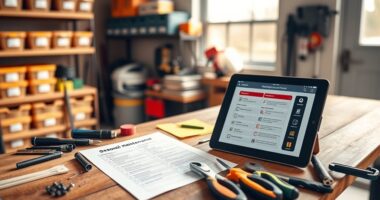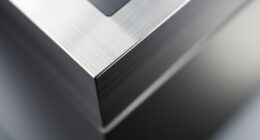To guarantee your pneumatic tools operate safely and last longer, always wear proper PPE like safety glasses and hearing protection. Make sure connections are secure before use and inspect hoses and parts for damage regularly. Lubricate moving components and drain moisture from the compressor often. Store tools properly and follow all manufacturer instructions. Proper use and upkeep prevent accidents, extend tool life, and keep performance at its best—continue to explore for more valuable maintenance tips.
Key Takeaways
- Always wear appropriate PPE and follow manufacturer instructions before operating pneumatic tools.
- Conduct regular inspections for damage, leaks, and wear, and maintain a clean workspace.
- Lubricate moving parts, check filters, and drain moisture routinely to ensure optimal tool performance.
- Replace worn or damaged parts promptly and avoid using compromised tools to ensure safety.
- Store tools properly, keep them in good condition, and follow maintenance schedules to extend lifespan.

Pneumatic tools are crucial in many industries for their power and efficiency, but using them properly is important to guarantee safety and longevity. To achieve this, you need to follow strict safety protocols and establish consistent maintenance routines. Safety should always come first; before operating any pneumatic tool, ensure you wear the appropriate personal protective equipment, such as safety glasses, hearing protection, and gloves. Familiarize yourself with the manufacturer’s instructions and safety guidelines, and double-check that all connections are secure. Never bypass safety features or modify tools in ways not approved by the manufacturer. Proper training is essential, so make sure you’re fully aware of how to handle the equipment correctly and understand emergency procedures in case of malfunctions or accidents.
Implementing safety protocols isn’t just about wearing gear—it’s also about inspecting your tools regularly. Before each use, check for signs of damage, such as leaks, cracks, or worn-out hoses. Damaged tools can lead to accidents or cause further damage to the equipment. Make sure to maintain a clean workspace, free from debris that could interfere with operation or cause tripping hazards. Properly securing workpieces and positioning yourself correctly during use also minimizes risk and ensures better control over the tool. Remember, rushing or ignoring safety rules increases the chances of injury and reduces the lifespan of your pneumatic tools.
Alongside safety protocols, maintaining your pneumatic tools through regular routines is key to their longevity and reliable performance. Develop and follow maintenance routines that include lubricating moving parts, checking air filters, and draining moisture from the compressor and hoses. Proper lubrication reduces friction and wear, preventing costly repairs and extending the tool’s lifespan. Clean dust and debris from vents and connections to prevent overheating and clogging. Replace worn-out parts promptly to avoid breakdowns during critical work. Keep your tools properly stored in a dry, organized area to prevent damage and corrosion. Remember, neglecting maintenance can lead to decreased efficiency, increased downtime, and more frequent repairs. Incorporating regular inspections into your routine can help catch issues early before they develop into costly problems.
Ultimately, combining diligent safety protocols with consistent maintenance routines ensures you get the most out of your pneumatic tools. Not only does this protect you from potential hazards, but it also prolongs the life of your equipment, saving you money and downtime in the long run. Taking the time to operate the tools correctly and caring for them properly is a smart investment that pays off with safer, more efficient workdays.
Frequently Asked Questions
How Do I Troubleshoot Pneumatic Tool Malfunctions?
When troubleshooting pneumatic tool malfunctions, first check the air pressure adjustment to guarantee it’s within the recommended range. Inspect for leaks or obstructions in the air supply. Use proper lubrication techniques to keep internal parts functioning smoothly. If the tool still misfires or stalls, clean or replace worn components. Regular maintenance and adjustments help prevent issues, making sure your pneumatic tools work efficiently and last longer.
What Safety Gear Is Recommended When Using Pneumatic Tools?
When using pneumatic tools, you should always wear protective gloves to prevent injuries and hearing protection to guard against loud noises. Safety goggles are also recommended to shield your eyes from debris. Make sure your gear fits properly and is in good condition. Wearing the right safety equipment guarantees you stay safe while operating pneumatic tools, reducing the risk of accidents and long-term hearing loss.
How Often Should I Replace Pneumatic Tool Air Filters?
Replacing your pneumatic tool air filters is like changing a car’s oil; regular care keeps everything running smoothly. You should check your air filter regularly, ideally every 1 to 3 months, depending on usage and air quality. Follow your filter replacement schedule closely, and replace filters whenever they show signs of dirt or clogging. Consistent air filter maintenance guarantees your tools stay efficient and prevent costly repairs.
Can Pneumatic Tools Be Used Underwater Safely?
You shouldn’t use pneumatic tools underwater without proper waterproofing measures. Water and moisture can damage internal components, risking safety and tool failure. If you need underwater maintenance, ensure the tool is specifically rated for submersion or adequately waterproofed. Always follow the manufacturer’s guidelines for underwater use, and regularly inspect seals and connections to prevent leaks. Proper waterproofing and maintenance are essential for safe, effective underwater pneumatic tool operation.
What Are the Environmental Impacts of Pneumatic Tools?
You should be aware that pneumatic tools can contribute to environmental impacts through emissions and noise pollution. Their environmental emissions, mainly from air leaks or exhaust, can harm air quality, while the noise they generate may disturb wildlife and nearby communities. To minimize these impacts, you need to maintain your tools properly, use quieter models when possible, and follow regulations to reduce emissions and noise levels effectively.
Conclusion
By following these simple tips, you’ll turn your pneumatic tools into unstoppable powerhouses that never break down or let you down. Neglecting proper use and upkeep could turn your workshop into a disaster zone faster than you can say “air pressure,” costing you time, money, and sanity. Stay vigilant, maintain regularly, and treat your tools like the treasure they are—because with proper care, they’ll work like magic, transforming your projects into masterpieces every single time!









